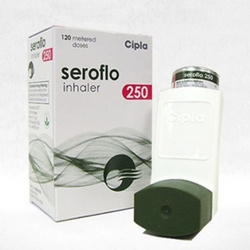Seroflo Inhaler
Active substance
Salmeterol + Fluticasone. Bronchodilating agent (beta2-adrenergic agonist + local glucocorticosteroid)
Pharmacological effect
The inhaler is a combined drug, which consists of two active components: fluticasone and salmeterol. These substances belong to different classes (synthetic fluorinated glucocorticosteroid and long-acting selective beta2-adrenergic receptor agonist). They have different mechanisms of action.
Fluticasone is a synthetic topical glucocorticosteroid with pronounced anti-inflammatory and anti-allergic properties. Due to its use, the permeability of capillaries decreases, exudation disappears, mucus secretion by glands decreases, and patency of the bronchial tree is restored.
Salmeterol is a selective long-acting beta2-adrenoreceptor agonist. It relaxes the smooth muscles of the bronchial wall. It suppresses the early and late stages of an allergic reaction. After single-dose administration, bronchial hyperreactivity decreases, the late-stage suppression lasts 30 hours, when the bronchodilating effect already disappears. Salmeterol prevents bronchospasm, reduces airway resistance, increases lung capacity. In therapeutic doses, it provides no effect on the cardiovascular system.
Dosage
The drug is intended for inhalation. It is applied for bronchial asthma
Adults and teenagers over 12 years old:
- dosage of 25 mcg / 50 mcg: 2 puffs 2 times a day.
- dosage of 25 mcg / 125 mcg: 2 puffs 2 times a day.
- dosage of 25 mcg / 250 mcg: 2 puffs 2 times a day.
Children from 4 to 12 years old: dosage of 25 mcg/50 mcg: 2 puffs 2 times a day.
Chronic Obstructive Pulmonary Disease (COPD):
- dosage of 25 mcg/125 mcg: 2 puffs 2 times a day.
- dosage of 25 mcg/250 mcg: 2 puffs 2 times a day.
This inhaler is intended to be taken in a minimally effective dose as it provides control of disease symptoms. When achieving the effect by applying this inhaler 2 times a day, it is recommended to decrease the dose to the minimum. The daily recommended time of the reception is once a day. The rate of fluticasone in the chosen form should comply with the disease severity.
This drug is used on a regular basis, even if bronchial asthma and COPD symptoms disappear at this time. The doctor prescribes therapy and the drug dose on an individual basis. The dose adjustment is not required in elderly patients and patients suffering hepatic and renal pathologies.
Side effects
One should expect adverse reactions’ development characteristic of each component individually. Additional side effects with the simultaneous use of two components of the drug are not observed.
The most common side effects caused by Seroflo inhaler are:
- cardiovascular system: cardiac arrhythmias, tachycardia, palpitations, myocardial ischemia.
- nervous system: headaches, including migraine, sleep disorders, tremors, behavioral disorders, including hyperreactivity and irritability, anxiety.
- immune system: hypersensitivity reactions, including rash and angioedema, shortness of breath and bronchospasm, anaphylactic reactions, allergic rhinitis, and conjunctivitis.
- respiratory system: nosebleeds, nasal congestion, dry nasal mucous membranes, laryngitis, hoarseness.
- gastrointestinal tract: irritation of oropharynx mucous membranes, changes in taste, hyposalivation, infections of the gastrointestinal tract, abdominal pains, increased gas formation, constipation, hemorrhoids.
- skin: hemorrhages, eczema, dermatitis, and dermatosis.
- musculoskeletal system: cramps in muscles, pain in bones and joints.
- infections and infestations: candidiasis of the oral mucosa and pharynx, urinary tract infections, respiratory infections, other bacterial and viral infections.
On the background of the drug use, the development of paradoxical bronchospasm is possible. In this case, you should immediately stop using the drug, assess the patient’s condition and, if necessary, prescribe alternative therapy.
Seroflo is possible to provoke temporary systemic reactions, including Itsenko-Cushing’s syndrome, inhibition of adrenal function, growth retardation in children and adolescents, a decrease in bone mineral density, cataracts, glaucoma, hyperglycemia.
With an overdose, tremor, headache, and tachycardia may develop.
Cardioselective beta-adrenergic blockers are used as optimal antidotes. They should be used with caution in the treatment of patients with a bronchospasm diagnosis. If treatment must be discontinued due to an overdose of the beta2-agonist, appropriate replacement therapy with GCS should be prescribed to the patient.
With prolonged use in doses exceeding the recommended, some suppression of adrenal cortex function is possible, in connection with which it is recommended to monitor the reserve function of the adrenal cortex.
Contraindications
- Hypersensitivity to salmeterol, fluticasone and other components of the drug;
- Children under 4 years old.
It is necessary to prescribe this inhaler with caution for the following diseases and conditions:
- tuberculosis;
- fungal, viral or bacterial infections;
- pheochromocytoma;
- thyrotoxicosis;
- hypothyroidism;
- diabetes mellitus;
- uncontrolled hypokalemia;
- uncontrolled arterial hypertension;
- arrhythmias;
- coronary heart disease;
- prolongation of the QT interval on an electrocardiogram;
- electrocardiogram stenosis;
- cataract;
- glaucoma;
- osteoporosis;
- pregnancy;
- lactation.
Interaction
Under normal conditions, low concentrations of salmeterol and fluticasone in the blood plasma are achieved, however, potential interaction with other substrates or inhibitors of the CYP3A4 isoenzyme should be avoided.
It is recommended to avoid the use of non-selective and selective beta-blockers if patients suffer from bronchial asthma. There is the danger of developing bronchospasm. Use in combination with beta-blockers is prescribed only in the presence of strict indications.
The combined use with other agents containing beta2-adrenoreceptor agonists can result in increased effects.
Pregnancy and lactation
The use during pregnancy and breastfeeding is permissible only if the potential benefit to the mother outweighs the potential risk to the fetus or infant.
